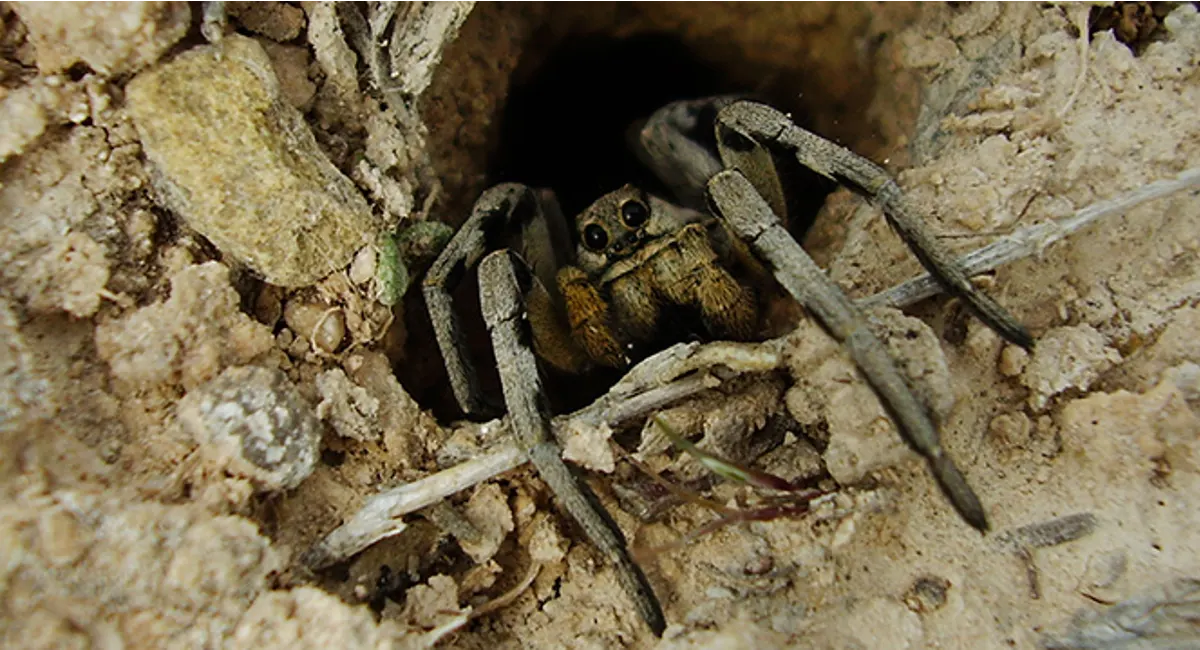For your Home
Login or register for the customer portal
The wolf spider is a creature that people, understandably, tend to find unnerving. Wolf spiders are hunters; actually, they don’t even create webs.
Their namesake comes from their reputation as hunters and the misconception that wolf spiders hunt in packs – but in reality, they hunt alone. Wolf spiders are quick runners and pursue their prey.
Keep reading to learn about different kinds of wolf spiders, their bites, and when throughout the year you might more often encounter them in your home.

The U.S. and Canada contain more than 100 wolf spider species. Here are some examples:
Adult females are ⅞ to 1 ⅜ inch long and males are ¾ inches long. Hogna carolinensis is brown with gray hairs on its front section and the abdomen has a stripe. This spider typically creates a burrow in the ground and can be found throughout the U.S.
Adult females of this species grow to ¾ inch to 1 inch long, and males are ⅝ to ¾ inches. It’s brown and the front portion has gray hairs and a line of yellow hairs in the eye area. Males’ front section is a bit lighter. The abdomen is striped. Hogna aspersa normally makes a burrow under the ground. Its geographic distribution ranges from New England and out to Nebraska.
Adult females grow to ⅝ to ⅞ inches long and males can be as big as 7/16 inches. The front section of its body has two dark stripes. and the abdomen has a dark stripe with light lines around it. In males, their first pair of legs is dark brown to black. This spider can be found in New England down to Florida and out to Nebraska and Oklahoma.
Adult females are 7/16 to ⅝ inches long and males are ½ to ⅝ inches. This type of wolf spider’s front portion has two stripes and its abdomen has a stripe in the middle. This spider’s distribution in the U.S. ranges from New England down to Florida and as far west as the Rocky Mountains.

Wolf spiders are relatively large, hairy spiders with a dull color and a funnel-like web. They have great eyesight that allows them to see and capture prey. In fact, they have eight eyes, which you’ll find in three rows. Two big eyes look ahead, while four small eyes appear underneath. Two other medium-sized eyes are located on the sides.
These pests appear in brown, black, gray, orange, and yellow colors (they can be a single color but they typically have different colored marks or stripes). Usually a dark brown color, wolf spiders can grow to be over an inch big and have hair on their bodies. They are hunters, meaning they hunt their prey not with webs but with their fast running ability.
Wolf spiders are mostly nocturnal, meaning they hunt their prey at night and hide in sheltered areas during the day. Outside, they are often found in yards under stones, piles of wood, leaves, and other debris. Although they prefer to be outdoors, wolf spiders may make their way inside and be found along walls or under furniture. Inside, they can be typically be seen along walls, windows, garages, basements, and houseplants. They move extremely fast and hunt a variety of insects.
The wolf spider is venomous and its bite can be painful. Compared to the bites of the black widow and brown recluse spider, which can produce more severe effects, the wolf spider bite is not likely to be detrimental. Still, if you have an allergic reaction or encounter severe symptoms (such as necrosis), seek medical attention immediately.
However, people are typically not bitten by wolf spiders. Bites are extremely rare and only occur when they are provoked or handled. In fact, they prefer to stay away from human contact entirely. If the spider is threatened, it may first retreat or rear up on its legs to expose its fangs.
Wolf spider babies hatch from eggs. Interestingly, in a number of species, wolf spider spiderlings travel by riding on the female spider before they head out to live their own lives. It’s possible for their colors to change as they get older. Male wolf spiders often live no more than one year; however, some females are able to live several years. Females are commonly larger than males within a single species. Some wolf spiders are out and about when it’s daytime, but others are active at night.
While somewhat dependent upon where you’re located in the U.S., wolf spiders are most often found in houses during the fall. This is because your home is a perfect spot to spend the winter and wolf spiders can also feed on overwintering insects.
We recommend placing traps that are sticky, such as glue boards, in room corners to catch wolf spiders. If it’s possible to capture one that’s alive, try to release it outside. Wolf spiders eat insects and can help decrease the number of pests around your home. Not sure how to eliminate spiders from your home? Contact Ehrlich online or call 1-888-976-4649.
Our new pricing tool can help you get a better estimated cost using a few factors like: